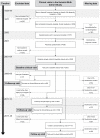Body Composition in Late Midlife as a Predictor of Accelerated Age-associated Deficit-accumulation From Late Midlife into Old Age: A Longitudinal Birth Cohort Study
- PMID: 36434783
- PMCID: PMC10235203
- DOI: 10.1093/gerona/glac233
Body Composition in Late Midlife as a Predictor of Accelerated Age-associated Deficit-accumulation From Late Midlife into Old Age: A Longitudinal Birth Cohort Study
Abstract
Background: Body mass index (BMI) may not be an optimal predictor of frailty as its constituents, lean and fat mass, may have opposite associations with frailty.
Methods: A linear mixed model analysis was performed in the Helsinki Birth Cohort Study (n = 2 000) spanning from 57 to 84 years. A 39-item frailty index (FI) was calculated on three occasions over 17 years. Body composition in late midlife included BMI, percent body fat (%BF), waist-to-hip ratio (WHR), lean mass index (LMI), and fat mass index (FMI).
Results: Mean FI levels increased by 0.28%/year among men and by 0.34%/year among women. Among women, per each kg/m2 higher BMI and each unit higher %BF the increases in FI levels per year were 0.013 percentage points (PP) steeper (95% CI = 0.004, 0.023) and 0.009 PP steeper (95% CI = 0.002, 0.016) from late midlife into old age. Among men, per each 0.1-unit greater WHR the increase in FI levels was 0.074 PP steeper per year (95% CI = -0.0004, 0.148). Cross-sectionally, greater FMI and LMI in late midlife were associated with higher FI levels but the direction of the association regarding LMI changed after adjustment for FMI. The categories "high FMI and high LMI" and "high FMI and low LMI" showed the highest FI levels relative to the category "low FMI and low LMI".
Conclusions: In late midlife, greater adiposity (%BF) among women and abdominal obesity (WHR) among men may predispose to higher levels of frailty from late midlife into old age. Greater lean mass alone may be protective of frailty, but not in the presence of high fat mass.
Keywords: Body composition; Frailty; Life-course; Risk factor.
© The Author(s) 2022. Published by Oxford University Press on behalf of The Gerontological Society of America.
Conflict of interest statement
None declared
Figures



References
Publication types
MeSH terms
LinkOut - more resources
Full Text Sources
Miscellaneous

